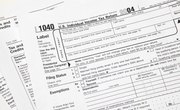
If you exceed your filing status’ minimum income threshold for filing taxes, then the IRS expects you to report all wages, regardless of the amount. According to the IRS, it is a widespread misconception that wages under $600 aren’t taxed or do not have to be reported.
While it is true that companies paying independent or self-employed contractors are not required to supply them with a 1099-NEC for jobs less than $600, this has no bearing on whether you report this income to the IRS. Workers who receive a W-2 from a company with less than $600 in wages are still responsible for reporting it, as there is no W-2 minimum amount to file.
Tips
Although you may not make enough income to require reporting to the federal government, you are still responsible for completing and returning all W-2 forms you receive, regardless of how much income you have earned.
Minimum Amounts to File Taxes
The IRS makes it rather easy to determine who has to pay federal income tax or not and there is no minimum income to receive a W-2. Each year, it releases new minimum income filing thresholds adjusted for inflation. These thresholds depend upon filing status, age and marital status, among other criteria. Fortunately, there are interactive tax assistant tools on the IRS' website, that help you figure your filing status, and whether taxes need to be filed.
Here are the income threshold requirements before a worker must file a tax return in 2020:
Single Filers
- 65 and under – $12,200
- 65 and older – $13,850
Married Filing Jointly
- Both spouses under 65 – $24,400
- One spouse 65 and older – $25,700
- Both spouses 65 years and older – $27,000
Married Filing Separately Status
- Any age – $5
Head of Household Status
- 65 and under – $18,350
- 65 and older – $20,000
Qualifying Widow/er Status
- 65 and under – $24,400
- 65 and over – $25,700
Deciding to File
If your total wages from all jobs and all W-2s you received for the year are less than any of these amounts for your filing status, then you do not need to file. However, if your income was from self-employment, then you must file if you earned more than $400 in the year.
Keep in mind, not being required to file doesn’t mean it isn’t a good idea for you to do so. The IRS offers refundable tax credits to assist low and moderate income workers that you might be eligible for – even if you have no tax liability – which could result in a refund for you.
Don’t Miss Your Tax Refund
Although you may not be required to file taxes for wages under $600 on a W-2, if that was your only income, you might still qualify for refundable tax credits. There are two types of tax credits – refundable and nonrefundable. Refundable tax credits allow you to keep all or a portion of a credit, even when your tax liability is at zero or has been reduced to zero.
This means if you owe no taxes, but still qualify for one of the fully or partially refundable tax credits, then you will receive the credit in form of a refund, unless you have outstanding obligations such as back child support payments or taxes. However, if you do not file because you are not obligated to, then you will not receive these credits. Uncle Sam is not in the habit of alerting workers that they are due a refund. It is your responsibility to determine what you’re eligible for and claim it.
As to be expected, the IRS has specific rules or tests that determine eligibility before one may claim these tax credits. A quick stop by the IRS’ website provides a complete list of all tax credits and deductions available to taxpayers for various years.
References
Writer Bio
Tara Thomas is a Los Angeles-based writer and avid world traveler. Her articles appear in various online publications, including Sapling, PocketSense, Zacks, Livestrong, Modern Mom and SF Gate. Thomas has a Bachelor of Science in marine biology from California State University, Long Beach and spent 10 years as a mortgage consultant.
